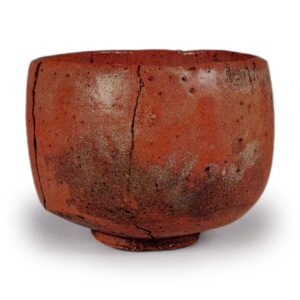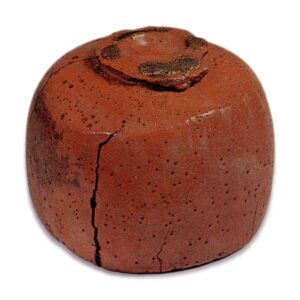

Height 9.9cm, mouth diameter 11.9cm, base diameter 5.9cm
On the front of the lid of the inner box, there is a note “Bishiyamontowo Aka Koetsu Tea Bowl, with calligraphy by Hisayoshi Tegaki (stamped with a flower) Gennasai Takaso” and on the back of the lid, “This tea bowl was presented by Koetsu to Yamashina-no Miya-sama, and was sent to this direction from Takano Korehisa. In other words, Koetsu presented the bowl to the head priest of Yamashina Bishamondo, which was received by the official physician Takano Zekan, and then passed on to Hisaya, and later to Konoike Zen’emon in Osaka, where it remained until after World War II.
Koetsu seems to have consciously produced red tea bowls with a rounded, rich, and interesting appearance, and his representative works such as “Bishamondo,” “Otogozen,” and “Seppou” are highly praised. Moreover, each of these works differs from the next, and Koetsu seems to have played freely with his art as his mind dictated. Among them, this “Bishamondo” is the tautest and most formidable.
The mouth is held inward, the body is rounded, and the waist is further rounded to a high stand. The two edges of the mouth are sharply spatulate, and one side of the waist is clearly spatulate in a chamfered pattern, adding a sense of power to the otherwise gentle appearance.
This type of workmanship was not found in Chojiro ware tea bowls, and it may be said to be influenced by the taste of Furuta Oribe, who favored a more interesting “hiyougeita” style. The height of a tea bowl with such a spatula must naturally show an interesting artifice, and indeed, Koetsu has placed the incorrectly rounded height in a very haphazard manner and carved out the inside of the height in a rounded manner.
The white marks of various sizes are unevenly left on the tatami mats of the base. The clay is red clay, and one side of the glaze is well melted, the other side is white as if in a haze, and the area around the base has a light black fire discoloration. There are several kiln marks from the mouth to the body and around the base, which may be one of Koetsu’s characteristics. There are many small and large bubbles scattered on the glazed surface.



